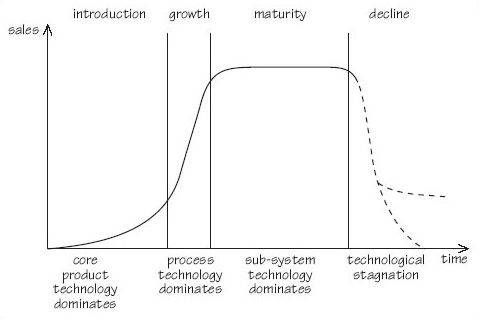1.8 Increasing complication, complexity and risk: are systems becoming more complex?
Figure 17 shows the evolution of two commonly encountered applications of systems – for personal transport and for the reproduction of recorded music. In both cases the degree of complexity of the systems application has increased over time. One of the main reasons for this is technology push. The importance of technology can be related to the stages of the product life cycle shown in Figure 18. The hypothesis behind Figure 18 is that the sales of a given product or product type (such as vinyl long-playing records) will in any given market follow the characteristic sales curve illustrated. The curve is divided into the stages of introduction, growth, maturity and decline, though more elaborate subdivisions are sometimes employed. No scales are shown on the axes of the graph since it is intended as a generic model that indicates internal relativities. During the introduction phase the core product technology is established along with its basic functions. It is rare for a product to address basic functions that are completely novel. For example, it is evident from the example shown in Figure 17 that the models for the early automobiles, or ‘horseless carriages’ with which they shared many components, were the earlier horse-drawn phaetons and other forms of carriage. The early automobiles inherited the functionality of horse-drawn carriages.


From that time until about 1910, the concept of the automobile was elaborated and its performance extended. The industry then entered the rapid growth phase, largely as a result of Henry Ford's application of assembly-line technology to car production (Ford, 1922; Sloan, 1965). By the 1950s the industry had entered the mature phase in the USA and technological innovation was directed at product sub-systems or improvements to the basic production methods. This process has continued up to the present time but, in addition, the development of computing and communications technologies has affected both cars and the way in which they are made. The universality of these technologies has meant that they have driven change in almost every industry and have, for example, fundamentally altered music reproduction, first with the introduction of digital compact discs and then with digital music recordings available for download from internet sites.
The application of computing and communications technologies to both automobiles and music reproduction illustrates a general tendency of systems to become more connected and, as a consequence, for the degree of coupling to increase. A car being driven is connected to traffic monitoring, police surveillance, and possibly global positioning systems, in ways that would have been impossible ten years ago. Similarly, the MP3 music reproduction system works by downloading into its memory music from a personal computer that is likely, in turn, to have been obtained from a website. Previously, cars and music systems were connected to their environment by the actions of humans. These interposed an intelligent buffer between the various elements in what becomes progressively a ‘system of systems’. One effect of this is to make the operation of any one system less complex since human actions filter out variation. However, human actions are themselves also a source of variation and complexity which make the operation of the system of systems more uncertain. The replacement of human by technological links increases the size of the system and reduces human interaction. As a result, people are relegated to a position on the periphery of increasingly massive systems over which they can exert less and less control.
